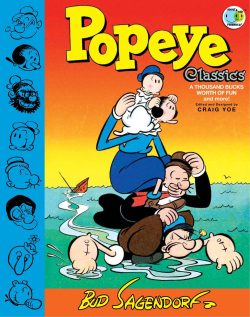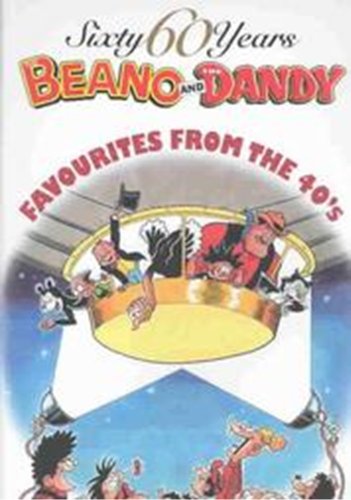
By many & various (DC Thomson & Co)
ISBN: 978-0-85116-821-0 (HB)
I couldn’t let the occasion pass unremarked, so here’s a suggestion of better times and more carefree entertainments to celebrate Britain’s longest running comic. On July 30th 1938, The Beano was unleashed upon the Great British Public…
Released in 2003 as part of the DC Thomson’s Sixtieth Anniversary celebrations for their children’s periodicals division – which has more than any other shaped the psyche of generations of kids – this splendidly oversized (296 x 204mm) 144 page hardback compilation rightly glories in the incredible wealth of ebullient creativity that paraded through the flimsy colourful pages of The Beano and The Dandy during a particularly bleak and fraught period in British history. Tragically, neither it nor its companion volumes are available digitally yet, but hope springs ever eternal…
Admittedly the book goes through some rather elaborate editing and paste-up additions whilst editorially explaining for modern readers the vast changes to the once-commonplace that have occurred over eight decades, and naturally the editors have expurgated a few of the more egregious terms that wouldn’t sit well with 21st century sensibilities (Mussolini lampoon Musso the Wop becomes the far-less ethnically unsound “Mussoâ€, for instance) but otherwise this is a superb cartoon commemoration of one of the greatest morale-building initiatives this nation ever enjoyed.
They’re also superbly timeless examples of cartoon storytelling at its best…
Until it folded and was reborn as a digital publication on 4th December 2012, The Dandy was the third-longest running comic in the world (behind Italy’s Il Giornalino – launched in 1924 – and America’s Detective Comics in March 1937).
Premiering on December 4th 1937, The Dandy broke the mould of traditional British predecessors by using word balloons and captions rather than narrative blocks of text under the sequential picture frames.
A huge success, it was followed eight months later by The Beano – which launched on July 30th 1938 – and together they utterly revolutionised the way children’s publications looked and, most importantly, how they were read.
Over the decades the “terrible twins†spawned a bevy of unforgettable and beloved household names who delighted countless avid and devoted readers, and the unmissable end of year celebrations were graced with bumper bonanzas of the comics’ weekly stars in extended stories in magnificent bumper hardback annuals.
As WWII progressed, rationing of paper and ink forced the “children’s papers†into an alternating fortnightly schedule: on September 6th 1941, only The Dandy was published. A week later just The Beano appeared. The rascally rapscallions only returned to normal weekly editions on 30th July 1949.
This superb tribute of Celtic creativity is packed literally cover-to-cover with brilliant strips and the mirth starts on the inside front with a wonderful Biffo the Bear exploit, illustrated by indisputable key man Dudley D. Watkins, followed by a sharp Korky the Cat gag-page by James Crichton and a listing of ‘Forty from the 40’s’, before the vintage fun properly proceeds, sensibly sub-divided into themed chapters.
Sadly, none of the writers are named and precious few of the artists, but I’ve offered a best guess as to whom we should thank, and of course I would be so very happy if anybody could confirm or deny my suppositions…
Then and Now offers a smart selection of comparisons to life in the past measured against 21st century existence, with hilarious examples and contributions from Lord Snooty – by the incredibly prolific Watkins – cowboy superman Desperate Dan at the doctor’s, ostrich antics with Big Eggo (by Crichton or perhaps Reg Carter), Wild West woman sheriff Ding-Dong Belle – from Bill Holroyd – and a glimpse at primitive fast-food courtesy of Dandy‘s Bamboo Town duo Bongo and Pongo as limned by Charlie Gordon.
There’s medical mirth with Desperate Dan, wash day blues with Mickey’s Magic Book (Crichton?) and a prose yarn pinpointing the funnier points of the class war in The Slapdash Circus – with a stirring illustration by Toby Baines – before Charlie Chutney the Comical Cook (Allan Morley) plays pie-man, whilst Watkins produces another Biffo blast.
Next comes The Horse That Jack Built, a rousing medieval adventure yarn starring a clockwork charger by Holroyd, and the chapter concludes in another Desperate Dan fable about messing around growing vegetables…
Entertainment explores how fun was had in the war years – i.e. before television – beginning with a phonographic Korky yarn and the first fine example of licensed film feature Our Gang illustrated by that man Watkins.
In case you were wondering… Our Gang (later known as Li’l Rascals) movie shorts were one of the most popular series in Film history. Beginning in 1922, they featured the fun and folksy humour of a bunch of “typical kids†(atypically, though, there was full racial equality and mingling – but the little girls were still always smarter than the boys) having idealised adventures in times both safer and simpler. The rotating cast of characters and slapstick shenanigans were the brainchild of film genius Hal Roach (who directed and worked with Harold Lloyd, Charley Chase and Laurel and Hardy amongst many others) and these brief cinematic paeans to a mythic childhood entered the “household name†category of popular Americana in amazingly swift order.
As times and tastes changed Roach was forced to sell up to the celluloid butcher’s shop of MGM in 1938, and the features suffered the same interference and loss of control that marred the later careers of the Marx Brothers, Laurel and Hardy and Buster Keaton.
In 1942, Dell Comics in the USA released an Our Gang comicbook written and drawn by Walt Kelly who, consummate craftsman that he was, restored the wit, verve and charm of the cinematic glory days with a progression of short tales that elevated the lower-class American childhood to the mythic peaks of Dorothy Gale in Oz or Huckleberry Finn.
Long before then, however (1937 and in The Dandy #1, in fact), DC Thomson had secured the British rights to produce their own uniquely home-grown weekly escapades of Alfalfa Switzer, Scotty Becket, Spanky McFarland, Darla Hood,Buckwheat Thomas and the rest, such as the quirky keep-fit frolic included here…
Desperate Dan then endures some cool radio fun with Aunt Aggie whilst Keyhole Kate (Allan Morley) has trouble with a Magic Lantern show, and Biffo’s juggling act brings nothing but pain and strife.
As depicted by the wonderful Eric Roberts, Podge find drumming is unwelcome around the village and the not-so-wild animals of Bamboo Town strike up – and out – the band, after which both Biffo and Korky suffer terribly for their R-and-R.
Posh poseur Swanky Lanky Liz (Charles Holt) comes a-cropper in a brace of telling tales after which the aforementioned dictator of Italy is mercilessly lambasted in a cruel quartet of Musso strips from Sam Fair, even as Charlie Chutney bakes to excess, Our Gang take vengeance on a bullying boxer and Podge foils a bunch of schoolboy cheats.
How the daily travails of conflict were relieved is examined in Wartime 1 with Jimmy and his Magic Patch (Watkins) accidentally visiting bellicose Lilliput, whilst Lord Snooty’s pals battle a Nazi spy and his pigeons and barmy barber Hair Oil Hal (by John Brown) cuts up in a clever quartet.
Sam Fair was in excoriating top form with the superbly manic Addie and Hermy slapstick assaults on Adolf Hitler and Hermann Wilhelm Göring/Goering, Meddlesome Matty (Fair or Malcolm Judge?) becomes a different sort of siren and Mickey’s Magic Book proves more hindrance than help during an air raid…
The complex world of Fashion begins with a plethora of Korky on parade, Beano’s Ding-Dong Belle offers some six-gun hints on good manners, Doubting Thomas (by Roberts) is overwhelmed by a shop dummy and Meddlesome Matty went shoe shopping… for a horse…
Hugh McNeil’s Pansy Potter, the Strongman’s Daughter was legendary for her unique looks – as seen in three strips here – but Swanky Lanky Liz, Charlie Chutney, Musso, Hair Oil Hal and Biffo all offer their own stylistic visions to round out this section before the un-PC past is more fully and shamefacedly explored in Out of Fashion. Here Biffo, Desperate Dan, Tin-Can Tommy, the Clockwork Boy (by the Torelli Brothers), Meddlesome Matty, Korky, Doubting Thomas, Bamboo Town and Mickey’s Magic Book all exhibit behaviours we just don’t condone nowadays…
Strips depicting Transport follow with Multy the Millionaire (Richard Cox), Korky and Biffo all experiencing some distress and delay after which Watkins displays his superb dramatic style for 1946 fantasy adventure Tom Thumb.
There are also more travel travails for Korky, Ding-Dong Belle, Doubting Thomas, Podge, Swanky Lanky Liz and Desperate Dan before a prose chapter from an epic Black Bob serial (a Lassie-like wonder dog illustrated by Jack Prout) precedes a Big Eggo pantomime romp and a 1944 Watkins spectacular starring Jimmy and his Magic Patch as a slave on a Roman ship.
Our trip down memory lane concludes with another bout of combat fever in Wartime 2, offering stunning contributions from Bamboo Town and Desperate Dan plus a treat for Pansy Potter fans: four fill-in strips illustrated by different artists who might or might not be McNeil, Basil Blackaller, Sam Fair, James Clark and/or Charles Grigg.
The campaign continues with a 1942 Tin-Can Tommy tale plus more Podge, Keyhole Kate, Doubting Thomas, Desperate Dan, and Korky strips as well as more Jimmy and his Magic Patch and a lovely Lord Snooty and his Pals yarn – with the kids helping the Home Guard – before Biffo ushers us out just as he had invited us in…
A marvel of nostalgia and timeless comics wonder, the true magic of this collection is the brilliant art and stories by a host of talents that have literally made Britons who they are today, and bravo to DC Thomson for letting them out for a half-day to run amok once again.
© 2003 DC Thomson & Co. Ltd. All rights reserved.






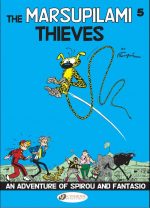 y André Franquin, translated by Jerome Saincantin (Cinebook)
y André Franquin, translated by Jerome Saincantin (Cinebook)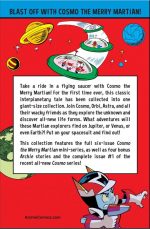
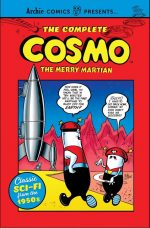


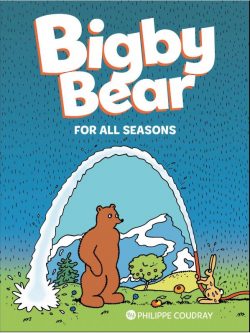
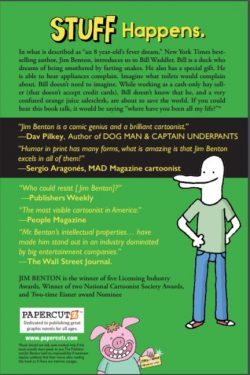
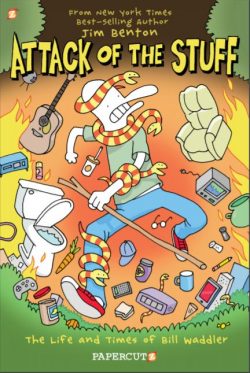
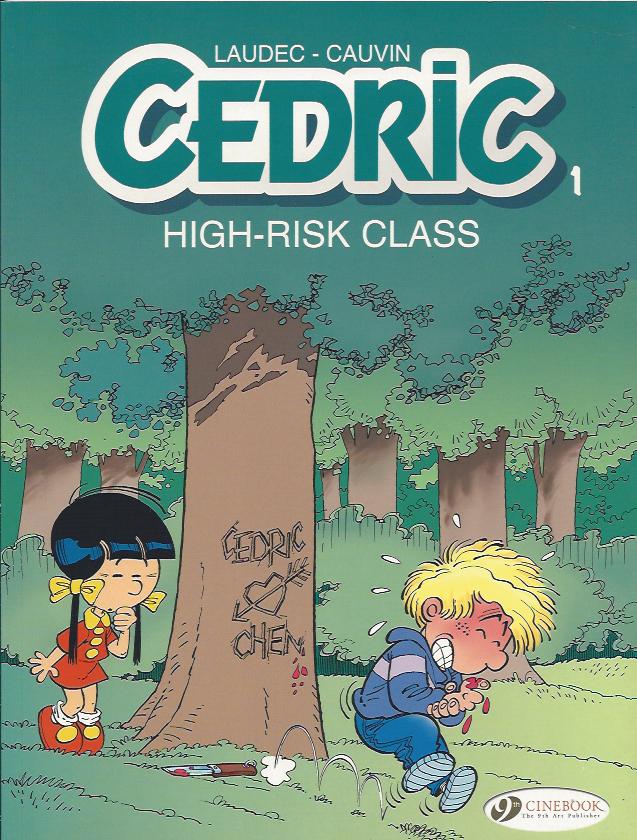

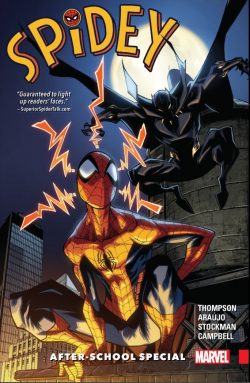
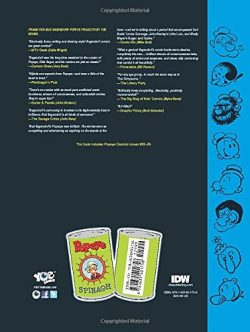 .
. 